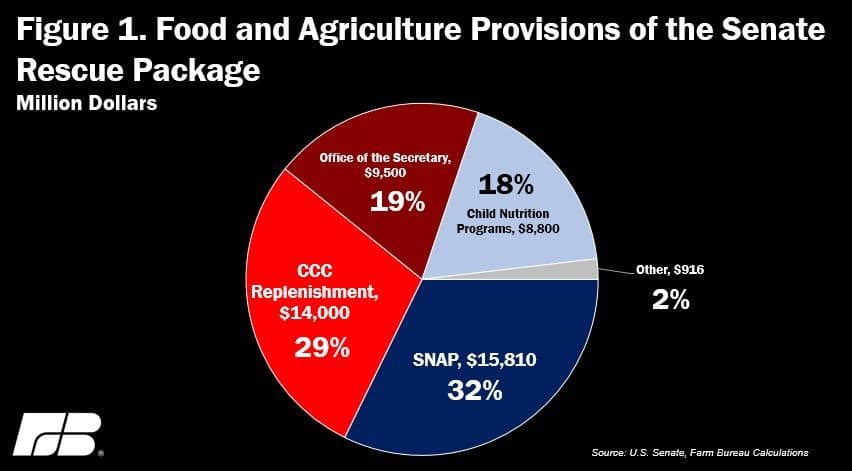Coronavirus Relief Bill: A Resource Guide for U.S. Farmers and Agricultural Producers
Emergency Relief Brings Funding to Critical Infrastructures
The Coronavirus Aid, Relief, and Economic Security (CARES) Act—phase three of the coronavirus stimulus package—was passed last week, resulting in a $2.3 trillion bill. This historic relief bill was approved unanimously by the Senate (96-0) to alleviate the economic pressures businesses and individuals are experiencing as they navigate the COVID-19 pandemic.
Since the signing of the Coronavirus Stimulus Package, the media has been flooded by information about the new legislation, making it difficult to keep track of how the aid will be distributed to those affected by the coronavirus.
With the objective to bring more clarity to the agriculture community, we’ve extracted the key pieces of legislation from the relief bill to help you understand,
- What programs or organizations are eligible for assistance;
- How individuals or business qualify for aid; and
- How to find resources to help your business if it’s been affected by the virus.
Contents:
- How Does the CARES Act Help the Agriculture and Food Industry?
- What is Included in the Families First Coronavirus Response Act?
- Small Businesses will Receive Relief in the Form of Backed Loans
- Stimulus Payments Will be Sent to Tax Paying Citizens in the Coming Weeks
- How will Agricultural Funding be Distributed?
- COVID-19’s Impact Farm Labor in 2020
- The Impact of the Novel Coronavirus (COVID-19) on the Future of Agriculture
How Does the CARES Act Help the Agriculture and Food Industry?
The $2 trillion relief plan includes $49 billion in funds for the agriculture and food industry, a critical industry according to the Department of Homeland Security. As one of 16 critical U.S. infrastructure sectors, this recognition helps to prioritize resources and funding for the businesses and organizations that maintain core operations.
The passing of this bill also represents the largest stimulus package in modern U.S. history–which speaks to the overwhelming effect that the coronavirus pandemic has had on resources and funding for our vital infrastructures, especially those that support our healthcare and food industries.
The $49 billion aid is planned to be dispersed into the sector through the following channels:
- Families First program that increases SNAP funding
- Small business relief in the form of backed loans
- Stimulus checks distributed to taxpayers who fall below a certain income level
- Various programs and grants within the agriculture sector allocated by the USDA
What is Included in the Families First Response Act?
The Families First Response Act is phase two of the COVID-19 relief plan. Phase one included an $8.3 billion bill that funded coronavirus vaccine research, treatment development, and state and local government functions. The Families First Response Act, which according to the American Action Forum, will cost an estimated $183.9 billion to meet the needs of American citizens.
There are four key provisions under this act that could potentially impact American farmers and their families, they are:
- Private-sector mandates on paid leave for workers;
- Expansion of unemployment-insurance benefits;
- Increase in Medicaid funding for free COVID-19 testing; and
- Additional assistance for nutritional food programs.
What this Act Means for Farmers and Ranchers
Farmers are ranchers should pay close attention to emergency paid sick leave and expanded family leave legislation to understand how to best support their employees during this time.
- The Emergency Paid Sick Leave Act (EPSLA): Both part-time and full-time employees are eligible for up to 10 days of paid sick leave with an 80-hour cap for full-time employees.
- Expanded Family and Medical Leave Expansion Act (EFMLEA): employees who have been employed for over thirty days are eligible for an additional ten weeks of partially paid leave and two weeks unpaid leave if they are caring for children whose schools are closed due to COVID-19.
Funding Deadlines for Families First Response Act
Paid sick and family medical leave provisions are limited to employees in businesses with fewer than 500 employees. Small businesses with fewer than 50 employees may qualify for exemptions regarding expanded family and medical leave if it jeopardizes the viability of the business. Emergency paid leave is not available for employees of businesses who have ceased or reduced operations due to the coronavirus pandemic. Employers must comply with FFCRA legislation from April 1 through December 31, 2020.
Small Businesses will Receive Relief in the Form of Backed Loans
The Coronavirus Aid, Relief, and Economic Security (CARES) Act allocated $349 billion in financial aid for small businesses, including eligible agricultural operations. This will be distributed by the Small Business Administration (SBA) through Paycheck Protection Program Loans (PPPL), which provides up to $10 million for qualifying small businesses and nonprofit organizations to assist with operating costs and payroll. This program was designed as a way for businesses to maintain payroll despite COVID-19 impacts. These loans are fully guaranteed by the federal government and available for businesses who,
- Have 500 employees or less;
- Are concerned about business for less than 12 months;
- Will use backed loans to cover salaries, commissions, paid leave, health-care benefits, mortgage interest, and utility payments; and
- Do not use funds to compensate employees who make over $100,000 annually or pay emergency sick leave that is under the Families First Phase 2 package.
While these backed loans will be a needed lifeline for many small businesses, agriculture groups have expressed concern that farm operations will be left out. Organizations like the National Farmers Union and the American Farm Bureau Federation stated the SBA is neglecting farm enterprises and limiting the use of these backed loans with stipulations such as not including payroll expenses for immigrant workers and independent contractors. However, SBA recently published an interim final rule addressing the issue.
Stimulus Payments Will be Sent to Tax Paying Citizens in the Coming Weeks
American citizens who filed taxes can expect a stimulus check of $1,200 per person, or $2,400 for married couples. Eligibility requirements include a maximum annual income of $75,000 or less, with an additional $500 per every dependent under the age of 17. Taxpayers with annual incomes between $75,000 and $99,000—or $150,000 to $198,000 if married—are eligible for a reduced stimulus check, on a sliding scale that falls by $5 for every $100 earned above the lower limit. Social security recipients will receive a check as long as the total income does not exceed the limit. Nonresident aliens and adult dependents claimed on someone else’s taxes are excluded from receiving a stimulus check.
Payments are said to begin disbursement in mid-April for those whose direct deposit information is on file with the Internal Revenue Service (IRS). Paper checks will take anywhere from weeks or months for distribution. Trump administration officials commented stimulus paper checks may take as long as 20 weeks to be distributed. Treasury Secretary Steven Mnuchin stated a web-based portal will possibly be used to register payment information for those they don’t have on file. However, this could be a potential issue for people without internet access.
The IRS will rely on the most recent tax returns for distribution, which will include 2018 returns if you have not filed for 2019. As a farm or ranch owner, keep in mind that eligibility is based on your personal tax returns and adjusted gross income. For more help in calculating your stimulus check, click the link below.
How will Agricultural Funding be Distributed?
Approximately half of the $49 billion relief aid that is designated for the agriculture and food sectors will go towards agricultural producers, the other half will fund nutritional programs and the expansion of SNAP benefits.
The Commodity Credit Corporation (CCC) will receive $14 billion to replenish agricultural assistance programs. The CCC is responsible for funding programs such as the Market Facilitation Program (MFP) and other commodity, conservation, and income support groups. The USDA will receive $9.5 billion for fruit and vegetable farmers, livestock producers, and specialty crop growers who have been affected by COVID-19. Financial support for local farmers who sell directly to consumers through farmers markets, schools, and restaurants are included in this sum. USDA is working on programs to distribute these funds, but have not yet announced their plan.
The chart below illustrates the allocation of the aid provisions across the food and agriculture sectors.

How will COVID-19 Impact Farm Labor in 2020?
Along with financial assistance from the relief program, the USDA announced their decision to temporarily loosen in-person interview requirements for H2-A and H2-B applicants to streamline the application process. This comes as welcomed news for farmers who depend on these workers to maintain food production.
Considering that farm labor has been a concern for farmers for some time, the recent events with COVID-19 coupled with planting season has brought the issue to the forefront. Border closures have many that rely on H2-A workers wondering if they will have sufficient hands when it comes time to harvest. While the State Department and Department of Homeland Security’s decision to wave in-person interviews to expedite the process offer some help, immigrant workers who’ve done seasonal work in the past are still facing challenges crossing the border, despite the obvious need.
USDA Secretary Sonny Perdue is continuing to work towards addressing the issue of farm labor shortage.
“H-2A labor is vital to the economy and food security of America—our farmers and producers depend on these workers to continue to feed and clothe the world.”
Farms and production plants are feeling the pressure to maintain the food supply chain while ensuring the safety of their workers. Many employees are staying home to take care of children or family members who have fallen ill. Some are refusing to work until stricter social distancing and health measures are in place. These novel challenges coupled with additional difficulty obtaining new immigrant workers due to border restrictions are exacerbating the issue of labor shortage in the agriculture industry. As unemployment skyrockets in the entertainment and hospitality industries, there’s a possibility more American workers will be searching for jobs in other industries. This could be an opportunity in a bleak situation for farmers to seek skilled laborers within our own borders.

To learn more about the implications of worker shortages on agriculture, download AgAmerica’s Farm Labor Shortage publication.
The Impact of the Novel Coronavirus (COVID-19) on the Future of Agriculture
COVID-19 has pushed agriculture to the forefront of fighting this unprecedented pandemic, along with the healthcare workers and first responders who face the impacts firsthand. Farmers fight in the way they know best, showing up each and every day for their crops and livestock to ensure the food security of our nation. It’s what they’ve done for more than a century and continue to do as we navigate this crisis together.
Will There be More Funding for the Coronavirus Stimulus Package?
A fourth and even fifth phase of the COVID-19 stimulus package will likely be passed as the crisis unfolds. AgAmerica Lending is working diligently to monitor the situation as it progresses and is committed to providing our clients and farmers across the country with the resources needed to make the best decision for their operation and their families. If you are concerned about the impacts of COVID-19 to your farm or ranch operation, contact our relationship managers to discuss financial solutions to help you through this challenging time.






